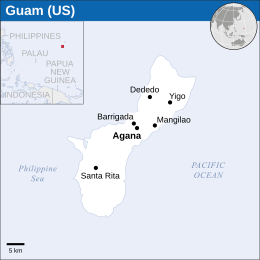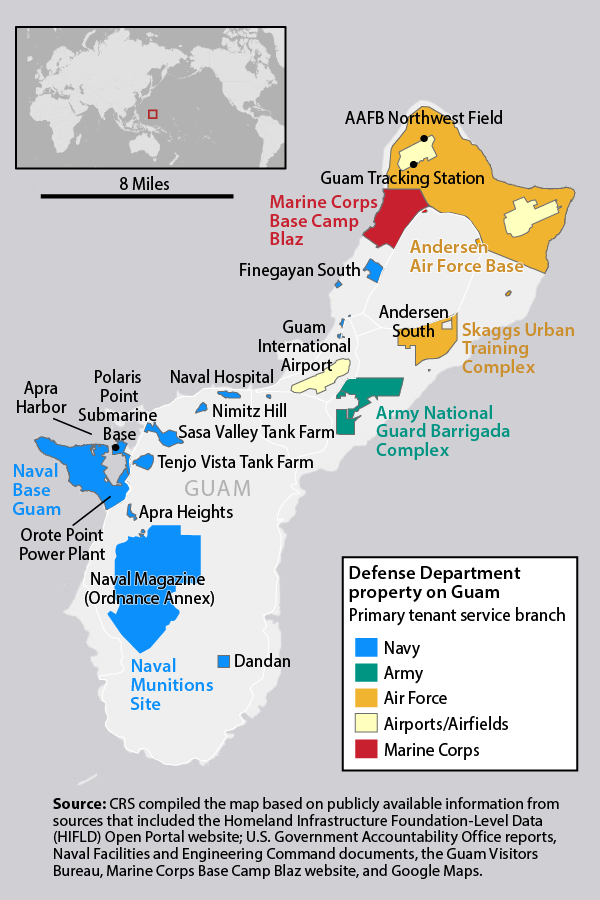More languages
More actions
mNo edit summary Tag: Visual edit |
Verda.Majo (talk | contribs) (added map of us military installations) Tag: Visual edit |
||
| (One intermediate revision by the same user not shown) | |||
| Line 1: | Line 1: | ||
{{Infobox country|name=Guam|native_name=Guåhan|image_flag=Flag of Guam.svg|capital=Hagåtña|largest_city=Dededo|mode_of_production=[[Capitalism]]|government_type=[[United States of America|U.S.]] military occupation|image_map=Guam map.svg|map_width=260|official_languages=Chamorro<br>English|area_km2=540|population_estimate=168,801|population_estimate_year=2021}} | {{Infobox country|name=Guam|native_name=Guåhan|image_flag=Flag of Guam.svg|capital=Hagåtña|largest_city=Dededo|mode_of_production=[[Capitalism]]|government_type=[[United States of America|U.S.]] military occupation|image_map=Guam map.svg|map_width=260|official_languages=Chamorro<br>English|area_km2=540|population_estimate=168,801|population_estimate_year=2021}} | ||
'''Guam''' is a [[United States of America|U.S.]] [[Colonialism|colony]] in the western Pacific Ocean. In January 2023, the [[United States Marine Corps|U.S. Marines]] opened a new base on the island that will contain 5,000 Marines to be used against [[People's Republic of China|China]].<ref>{{Web citation|author=Dave DeCamp|newspaper=Antiwar.com|title=US Marines Open New Base on Guam to Prepare for Future War With China|date=2023-01-26|url=https://news.antiwar.com/2023/01/26/us-marines-open-new-base-on-guam-to-prepare-for-future-war-with-china/|archive-url=https://web.archive.org/web/20230129194553/https://news.antiwar.com/2023/01/26/us-marines-open-new-base-on-guam-to-prepare-for-future-war-with-china/|archive-date=2023-01-29|retrieved=2023-02-04}}</ref> | '''Guam''' is a [[United States of America|U.S.]] [[Colonialism|colony]] in the western Pacific Ocean. It is the largest and southernmost of the [[Mariana Islands]] chain.<ref>Carson, Mike. [https://www.guampedia.com/micronesia-portal/ "Micronesia Portal: The Archeological Evidence."] Guampedia. [https://web.archive.org/web/20240409060642/https://www.guampedia.com/micronesia-portal/ Archived] 2024-04-09.</ref> | ||
27% of Guam's land is occupied by the US military and Guam is sometimes referred to as the "tip of the spear" of US military presence in the Pacific.<ref>Kenneth Gofigan Kuper. [https://fpif.org/guam-the-sharpening-of-the-spears-tip/ “Guam: The Sharpening of the Spear’s Tip.”] Foreign Policy In Focus, July 20, 2022. [https://web.archive.org/web/20240128004148/https://fpif.org/guam-the-sharpening-of-the-spears-tip/ Archived] 2024-01-28.</ref> In January 2023, the [[United States Marine Corps|U.S. Marines]] opened a new base on the island that will contain 5,000 Marines to be used against [[People's Republic of China|China]].<ref>{{Web citation|author=Dave DeCamp|newspaper=Antiwar.com|title=US Marines Open New Base on Guam to Prepare for Future War With China|date=2023-01-26|url=https://news.antiwar.com/2023/01/26/us-marines-open-new-base-on-guam-to-prepare-for-future-war-with-china/|archive-url=https://web.archive.org/web/20230129194553/https://news.antiwar.com/2023/01/26/us-marines-open-new-base-on-guam-to-prepare-for-future-war-with-china/|archive-date=2023-01-29|retrieved=2023-02-04}}</ref> | |||
== History == | == History == | ||
The first humans arrived in Guam between 2000 and 1500 BCE. [[Monarchy of Spain (1516–1700)|Spanish]] colonizers first arrived in 1521 and took over in the 1550s.<ref name=":02">{{Citation|author=David Vine|year=2020|title=The United States of War|chapter=The Military Opens Doors|page=203–4|city=Oakland|publisher=University of California Press|isbn=9780520972070|lg=http://library.lol/main/191568BFAC73F009132DB00ECD0F0F05}}</ref> | The first humans arrived in Guam between 2000 and 1500 BCE.<ref name=":02" /> CHamoru (also spelled Chamorro)<ref>Raquel Bagnol. [https://www.pacificislandtimes.com/post/chamoru-or-chamorro-the-spelling-confusion “CHamoru or Chamorro: The Spelling Confusion.”] Pacific Island Times, March 4, 2024.</ref> society developed with a matrilineal kinship and inheritance system, with the population organized into clans, as well as developing at least two social castes.<ref>Dominica Tolentino. [https://www.guampedia.com/ancient-chamorro-settlement-patterns/ "Ancient CHamoru Settlement Patterns."] Guampedia.</ref> The ancient people of Guam engaged in fishing and horticulture and lived both on the coasts and inland areas, cultivating yam, taro, breadfruit, banana, coconut, and rice, and catching a wide variety of fish. They passed down their history, genealogy, and legends through oral traditions such as songs, stories, and chants. CHamoru construction methods included building atop rows of large stone pillars known as ''latte.'' CHamoru people also built outrigger sailboats, known as proas, used for inter-island transportation and fishing.<ref>[https://nmimuseum.org/ancient-chamorro-period/ "Ancient Chamorro Period."] Northern Mariana Islands Museum of History and Culture. [https://web.archive.org/web/20231029045717/https://nmimuseum.org/ancient-chamorro-period/ Archived] 2023-10-29.</ref> | ||
[[Monarchy of Spain (1516–1700)|Spanish]] colonizers first arrived in 1521 and took over in the 1550s.<ref name=":02">{{Citation|author=David Vine|year=2020|title=The United States of War|chapter=The Military Opens Doors|page=203–4|city=Oakland|publisher=University of California Press|isbn=9780520972070|lg=http://library.lol/main/191568BFAC73F009132DB00ECD0F0F05}}</ref> Guam became a stop for provisions for Spanish ships travelling across the Pacific, and eventually, Jesuit missionaries began attempting religious conversions of the native CHamoru people in 1668. The CHamoru resisted the colonizers, to which the Spanish responded by stationing soldiers on Guam under a military governor.<ref name=":0">Rogers, Robert F. [https://www.guampedia.com/guams-strategic-value/ "Guam’s Strategic Value."] Guampedia. [https://web.archive.org/web/20240408172954/https://www.guampedia.com/guams-strategic-value/ Archived] 2024-04-08.</ref> | |||
[[File:U.S. Military Installations in Guam.png|alt=A map showing that much of Guam's land area is covered in U.S. military installations, such as Andersen Air Force Base, Naval Base Guam, Naval Munitions site, Army National Guard Barrigada Complex, Skaggs Urban Training Complex, Marine Corps Base Camp Blaz, among others.|thumb|A map showing several U.S. Military installations in Guam.]] | |||
In the period of the [[Spanish-American War]], the United States under President [[William McKinley]] invaded and occupied Guam in 1898 shortly after the invasion of [[Hawaii]],<ref>{{Web citation|author=Danny Shaw|newspaper=[[Liberation School]]|title=The struggle for self-determination in Hawaiʻi|date=2017-07-07|url=https://www.liberationschool.org/the-struggle-for-self-determination-in-hawaii/|archive-url=https://web.archive.org/web/20220925060224/https://www.liberationschool.org/the-struggle-for-self-determination-in-hawaii/|archive-date=2022-09-25|retrieved=2023-02-04}}</ref> beginning the US Naval era, during which the people of Guam lived under strict executive orders by the Naval government which significantly impacted culture, social and economic life, and placed strict limitations on political participation. During this time, the people of Guam continuously petitioned for more rights.<ref name=":1">Domenica Tolentino. [https://www.guampedia.com/politics_and_government/chamorro-quest-for-self-determination/ "CHamoru Quest for Self-Determination."] Guampedia. [https://web.archive.org/web/20240408172914/https://www.guampedia.com/politics_and_government/chamorro-quest-for-self-determination/ Archived] 2024-04-08.</ref> | |||
US Naval rule was interrupted when Guam was occupied by [[Empire of Japan (1868–1947)|Japan]] during the [[Second World War]]. After being re-occupied by the US, the Marianas islands were used for launching the air assault against Japan.<ref name=":0" /> The US continued to rule by mandate until 1950, when the Organic Act granted the people of Guam some limited aspects of self-government, though still remaining a US colonial possession without national sovereignty.<ref name=":1" /> | |||
Throughout the following years, the US occupiers continued to use Guam as a strategic base for its [[Imperialism|imperialist]] endeavors, using Guam to harbor nuclear missile submarines, long-range bombers, satellite and underwater cable communications centers, large facilities for electronic intelligence gathering, and stockpiles of conventional and nuclear weapons, as well as using Guam as a support base during the [[Korean War]], a base for [[B-52 bomber|B-52 bombers]] in the [[Vietnam War]], and as a logistical link to the U.S. base on [[Diego Garcia]] in the [[Indian Ocean]] for the [[Republic of Iraq#First US invasion|1991 Gulf War]] and the [[Iraq War|2003 Iraq War]].<ref name=":0" /> | |||
== References == | == References == | ||
[[Category:Colonial outposts]] | [[Category:Colonial outposts]] | ||
Latest revision as of 14:14, 2 May 2024
| Guam Guåhan | |
|---|---|
|
Flag | |
 | |
| Capital | Hagåtña |
| Largest city | Dededo |
| Official languages | Chamorro English |
| Dominant mode of production | Capitalism |
| Government | U.S. military occupation |
| Area | |
• Total | 540 km² |
| Population | |
• 2021 estimate | 168,801 |
Guam is a U.S. colony in the western Pacific Ocean. It is the largest and southernmost of the Mariana Islands chain.[1]
27% of Guam's land is occupied by the US military and Guam is sometimes referred to as the "tip of the spear" of US military presence in the Pacific.[2] In January 2023, the U.S. Marines opened a new base on the island that will contain 5,000 Marines to be used against China.[3]
History[edit | edit source]
The first humans arrived in Guam between 2000 and 1500 BCE.[4] CHamoru (also spelled Chamorro)[5] society developed with a matrilineal kinship and inheritance system, with the population organized into clans, as well as developing at least two social castes.[6] The ancient people of Guam engaged in fishing and horticulture and lived both on the coasts and inland areas, cultivating yam, taro, breadfruit, banana, coconut, and rice, and catching a wide variety of fish. They passed down their history, genealogy, and legends through oral traditions such as songs, stories, and chants. CHamoru construction methods included building atop rows of large stone pillars known as latte. CHamoru people also built outrigger sailboats, known as proas, used for inter-island transportation and fishing.[7]
Spanish colonizers first arrived in 1521 and took over in the 1550s.[4] Guam became a stop for provisions for Spanish ships travelling across the Pacific, and eventually, Jesuit missionaries began attempting religious conversions of the native CHamoru people in 1668. The CHamoru resisted the colonizers, to which the Spanish responded by stationing soldiers on Guam under a military governor.[8]

In the period of the Spanish-American War, the United States under President William McKinley invaded and occupied Guam in 1898 shortly after the invasion of Hawaii,[9] beginning the US Naval era, during which the people of Guam lived under strict executive orders by the Naval government which significantly impacted culture, social and economic life, and placed strict limitations on political participation. During this time, the people of Guam continuously petitioned for more rights.[10]
US Naval rule was interrupted when Guam was occupied by Japan during the Second World War. After being re-occupied by the US, the Marianas islands were used for launching the air assault against Japan.[8] The US continued to rule by mandate until 1950, when the Organic Act granted the people of Guam some limited aspects of self-government, though still remaining a US colonial possession without national sovereignty.[10]
Throughout the following years, the US occupiers continued to use Guam as a strategic base for its imperialist endeavors, using Guam to harbor nuclear missile submarines, long-range bombers, satellite and underwater cable communications centers, large facilities for electronic intelligence gathering, and stockpiles of conventional and nuclear weapons, as well as using Guam as a support base during the Korean War, a base for B-52 bombers in the Vietnam War, and as a logistical link to the U.S. base on Diego Garcia in the Indian Ocean for the 1991 Gulf War and the 2003 Iraq War.[8]
References[edit | edit source]
- ↑ Carson, Mike. "Micronesia Portal: The Archeological Evidence." Guampedia. Archived 2024-04-09.
- ↑ Kenneth Gofigan Kuper. “Guam: The Sharpening of the Spear’s Tip.” Foreign Policy In Focus, July 20, 2022. Archived 2024-01-28.
- ↑ Dave DeCamp (2023-01-26). "US Marines Open New Base on Guam to Prepare for Future War With China" Antiwar.com. Archived from the original on 2023-01-29. Retrieved 2023-02-04.
- ↑ 4.0 4.1 David Vine (2020). The United States of War: 'The Military Opens Doors' (pp. 203–4). Oakland: University of California Press. ISBN 9780520972070 [LG]
- ↑ Raquel Bagnol. “CHamoru or Chamorro: The Spelling Confusion.” Pacific Island Times, March 4, 2024.
- ↑ Dominica Tolentino. "Ancient CHamoru Settlement Patterns." Guampedia.
- ↑ "Ancient Chamorro Period." Northern Mariana Islands Museum of History and Culture. Archived 2023-10-29.
- ↑ 8.0 8.1 8.2 Rogers, Robert F. "Guam’s Strategic Value." Guampedia. Archived 2024-04-08.
- ↑ Danny Shaw (2017-07-07). "The struggle for self-determination in Hawaiʻi" Liberation School. Archived from the original on 2022-09-25. Retrieved 2023-02-04.
- ↑ 10.0 10.1 Domenica Tolentino. "CHamoru Quest for Self-Determination." Guampedia. Archived 2024-04-08.

